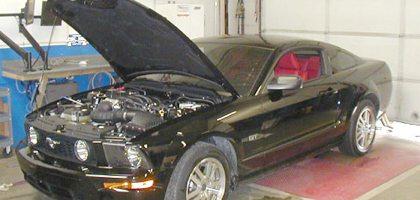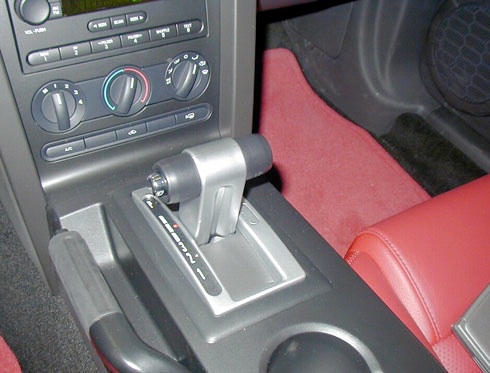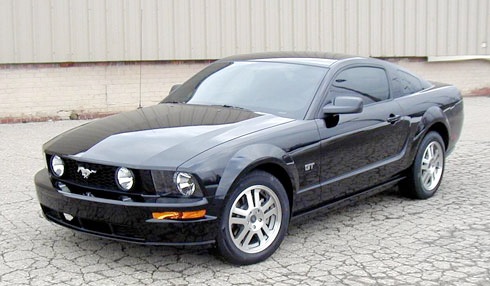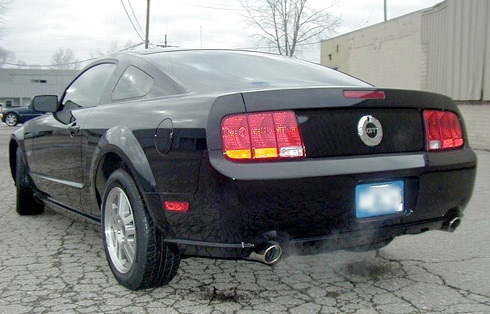16 Alternative Autos R & D 2005 Mustang GT
Alternative Auto’s R & D 2005 Mustang GT
Wednesday, February 16, 2005

Alternative Auto’s goal is always to be at the forefront of technology and performance. To that end, we have purchased a black 5-speed Automatic 2005 Mustang GT. With the many technological advancements and changes that have been made to the 3-Valve 4.6L in the ’05 GT Mustang in both the motor and the rest of the power train, we felt it was essential to have one of our own for ground-breaking R&D.
We’re ready to embrace and master all of its new technical features, starting with the Fly-By-Wire-Throttle, 3-Valve cylinder heads, variable cam timing, new PowerPC engine management systems, flash only tuning, and the new 5R55S five-speed Automatic trans just to mention a few.
With only a couple hundred miles on our new ’05 GT, it was on the dyno checking what it made totally stock at the rear wheels and then moved onto playing with the tune using 93 octane and removing the stock “Pre-Cat” from the intake track.
It’s no secret we love the Mustangs, but this vehicle is being purchased exclusively to use as an R&D platform to see what kind of performance we can achieve with the 3-Valve motor N/A and eventually with a supercharger. And above all to learn the new “5R55S” which is the new 5-speed automatic that we need to get used to in the 2005 and up Mustang GT.
The new “5R55S” 5-speed automatic has been used in a couple of other rear drive Ford’s for a few years but wasn’t given much attention because it was bolted to lower horsepower V-6’s and some Explorer’s with the 4.6L V-8’s. This is the first time it’s been used behind a relatively high HP performance V-8.
Unfortunately, the 5R55S is inherently weaker then the 4R70W 4-speed overdrive automatic that we’ve become very accustomed to in the last 10 years or so. Just for a little bit of background and experience – the 4R70W started to come in the 1993 Lincoln Mark-8 then 1994 5.0L trucks and was first used in the Mustang GT in 1996 with the 4.6L 2-Valve engines. It’s been improved a little here and there over the years and is still used today in the current F-150’s. In 2004, it was called the 4R75W because it got a couple of improvements giving it slightly greater torque handling capacity.
Over the last few years we found that you could take a completely stock 4R70W with just a shift kit, lay down some pretty big power through it, and they would hold up extremely well. Sadly, as tough as we thought the 4R70W was, Ford chose to not put it behind any of the Cobra’s with the 32-valve 4.6’s at all. It wasn’t until the ’03 Mach-1 came along that Ford finally put the 4R70W behind a 300hp 32-Valve in the Mustang platform. In our opinion Ford was about 5 years late on this one. This is why the Automatic equipped ’03 and ’04 Mach-1’s make a very appealing car to start with if you want to have a very powerful, consistent, reliable and easy to drive street/strip car.

The key reason we bought this car was to learn everything we could about the new 5R55S 5-Speed Automatic transmission. How to make it shift better when the car is all stock with some bolt-ons, and ultimately how much power it can take with supercharging.
The reason I say that the new 5R55S is inherently weaker then the previous 4R70W is for two reasons. The first reason is very easy to explain: the 5R55S is simply physically smaller then the 4R70W. We don’t know the extent of how much smaller the internals are in the 5R55S then a 4R70W, but it can be seen by simply looking at the two cases from the out side – other reliable sources have told us that the 5R55S’s internals are smaller then what were used to in the 4R70W. This doesn’t scare us from still trying to put 400 to maybe even as high as 450 RWHP through the 5R55S. In our experience, 500 to 600 RWHP through the 4R70W was common and relatively trouble-free.
The second and more complex potential weakness with the 5R55S is more difficult to explain and more of a concern than the fact that it’s physically smaller and that’s that the 5R55S shifts into 3rd and 4th gear “synchronously”. We’ll explain “synchronous” and “non-synchronous” shifts in a minute. You need to first understand that 4th gear in the new 5R55S is 1:1 ratio, which is the same as 3rd in all other automatics with and without overdrive gears more or less for the last 40+ years. This means that when drag racing the new Mustang equipped with the 5R55S for the full distance of the 1/4 mile. You’ll typically let the 5R55S go into 4th (1:1 Ratio) and stay there ‘til the end of the 1/4 mile. So, the 5R55S has to shift of course into 2nd then 3rd and then 4th at WOT while going down the track. This is going to make for some awesome ET’s, especially the non-power adder car’s. With the right rear gearing and torque converter, I feel the new 5-Speed automatic will easily rival the stick shift cars, finally.
This is where “synchronous” and “non-synchronous” shifting comes into play and will make it tricky to apply substantially higher power levels to the 5R55S.
A “non-synchronous” shift in an automatic trans means that when the trans shifts from one gear ratio to the next, it happens by applying only one clutch or band and nothing else has to happen. The “non-synchronous” shift is seamless and has no chance of a flare happening between the gear change. The best way to explain this in a very simple way is to picture a typical 10-speed pedal bicycle that you would have to shift manually (we’ve all ridden & shifted these). You could go up and down through the gears on those while pedaling with no loss of power to the rear tire essentially. They just shifted on the fly with no chance of hitting a neutral gear between the gears while shifting.
“Synchronous” shifts means that for a gear change to happen, one device, be it a Clutch or Band has to apply and something else has to release simultaneously. This is really not a problem at moderate power levels. But, when you start to hit the trans with some very high power levels, gear changes that have to happen “synchronously” can risk an rpm flare between the gear changes. This flair can happen because one thing has to apply and another thing in the trans has to release simultaneously. When this action is happening in the trans, if it doesn’t time them and perform them accurately, an rpm flair can happen between the two actions. This can be very damaging to the trans because the flair can shock the trans very hard when the gear change is finally completed. This (flare) is what caused the most common failure in the C-4 three speed automatics commonly used in Mustangs and other Ford’s in drag racing. The C-4’s shifted “synchronously” only into 3rd gear not 2nd. And this is when they would usually break in very high horsepower applications, when shifting into 3rd gear.

Hopefully by spring of 2005 we will have an aftermarket rim of some sort installed all the way around. We’re shooting for some kind of a 20” rim and a 295/40/20 tire possibly in the rear.
This is why the AOD’s, AOD-E’s and the 4R70W have proven to be so very tough in some pretty serious Ford street/strip race car applications for us. Those transmissions shift into 2nd and 3rd “Non- Synchronously” meaning the power flow through them cannot cause a damaging flare. They do although shift into 4th or over drive “synchronously” but we don’t typically go into over drive at WOT with these when drag racing. This is why our advice with the AOD’s and 4R70W’s was always “turn off OD when racing them or horsing around, and they’ll take a pretty good pounding.
Getting back to the 5R55S in the new 05 Mustang GT. The 5R55S shifts into 3rd and 4th “Non- synchronously”. 4th gear is the new 1 to 1 ratio, not 3rd like in most other automatics. We want to get into 4th or 1 to 1 for the most part in the 1/4 mile when racing. This means that the 5R55S could potentially flare during not one shift like C-4’s (2nd to 3rd)… but two of the needed gear changes when drag racing the 5R55S… 2nd to 3rd and 3rd to 4th.
As scary as this may sound for the beginning of a new era of the first 5-speed automatic’s in the Mustangs, I feel that things might not be as bad as it might seem at first. The 5R55S’s internals are about the size of a C-4 or slightly smaller we’ve been told.

We got our 05 GT without the optional rear wing because we plan to install an aftermarket type “Duck-Tale” style wing which gives the 05 GT the look of a mid 1960’s Shelby Mustang.
All we’ve chosen to do with the exhaust for now is replace the tip with a much better looking and more filing, rolled, stainless 3.5” piece. We’ve already found that the stock 2.5” exhaust is very efficient and will not need replacing for now, until substantial power levels are reached later on. The 05 GT’s stock exhaust is the loudest production exhaust we’ve ever heard. By keeping it stock and somewhat quite, it will help in listening for spark knock while tuning the car with and with out a blower.
C-4’s, when they don’t flare can hold up to as much as 700+ horsepower these days. This is why Alternative Auto has purchased our own 2005 GT with the new 5R55S automatic to see what it can take when we start to make what has become common place these days with EFI Mustangs equipped with blowers…. 450 to 500+ Rear Wheel Horsepower!
In the mid 90’s when Alternative Auto started to push and accept that the 4R70W could handle substantial power levels compared to most manual transmissions and clutches… most were skeptical, and yet we’ve gone on to prove right up until today that they could tolerate much more then we all expected. We’ve convinced and converted a lot of die hard stick guys over to the 4R70W side of things quite a bit in the last few years. I feel that the new 5R55S 5-speed automatic will handle a good amount of power as well, but I believe we will have to lower the power we throw at them a bit compared to the 4R70W’s.
We will update progress on the new automatic Mustang GT as we go in 2005. At first though we will try to extract as much as we can with very few changes, like bolts ons and lots of computer tuning with our SCT Xcalibrator3 Flash tuner. And like everything Alternative Auto touches, it will have a blower on it by mid to late 2005.
This is without a doubt, the fastest automatic trans equipped Mustang ever produced by the factory.
